Nigerian Goat
Capra aegagrus hircus
Produces a lot of milk for its small size
Advertisement
Nigerian Goat Scientific Classification
- Kingdom
- Animalia
- Phylum
- Chordata
- Class
- Mammalia
- Order
- Artiodactyla
- Family
- Calvo
- Genus
- Capra
- Scientific Name
- Capra aegagrus hircus
Read our Complete Guide to Classification of Animals.
Nigerian Goat Conservation Status
Nigerian Goat Facts
- Name Of Young
- Kid
- Group Behavior
- Herd
- Fun Fact
- Produces a lot of milk for its small size
- Estimated Population Size
- Unknown
- Biggest Threat
- Predatory birds and mammals
- Most Distinctive Feature
- Miniature size
- Gestation Period
- 145-154 days
- Litter Size
- 2-4
- Habitat
- Farmland
- Diet
- Herbivore
- Type
- Caprid
- Common Name
- Nigerian dwarf goat
- Location
- United States
- Group
- Herd
Nigerian Goat Physical Characteristics
- Color
- Brown
- Red
- Black
- White
- Gold
- Cream
- Skin Type
- Hair
- Lifespan
- 15 years
- Weight
- 40-70lbs
- Height
- 16-22in
- Age of Sexual Maturity
- 3-8 months
- Age of Weaning
- 30-60 days
View all of the Nigerian Goat images!
The Nigerian dwarf goat is a small goat species from the West African Dwarf goat breeds like the American Pygmy Goat.
The American breed was specifically developed to be a miniature, small-scale dairy goat. It has the same proportions as larger dairy goat breeds but much smaller. Popular for its characteristics of small size, easy maintenance, colorful markings, gentle, friendly, intelligent, and playful personality, it is a favorite as small livestock as well as a companion animal.
5 Incredible Facts!
- It’s one of the most expensive goat species.
- It produces a lot of milk compared to its size.
- The higher butterfat of the breed’s milk makes it popular for making cheese, cream, yogurt, and soap.
- It sometimes serves as a food source for carnivorous animals in zoos.
- Bottle feeding the kids promotes bonding with humans.
Scientific Name
The scientific name of the Nigerian dwarf Goat is Capra aegagrus hircus. All domestic goats are a subspecies of C. aegagrus originating from the wild goat from Eastern Europe and Southwest Asia. From this subspecies are more than 300 breeds, of which the Nigerian dwarf Goat is one. The description of a breed is simply a domesticated subspecies, so there is no scientific name for different breeds.
Appearance
The description of the Nigerian Dwarf Goat was initially as a show and companion animal, later becoming a dairy and meat goat. Like other goat breeds, physical characteristics include being even-toed ungulates, mammalian ruminants, and having horns, beards, and horizontal, slit-shaped pupils. There are specific height and weight ranges for each breed. For the Nigerian Dwarf Goat, it can sometimes be naturally hornless.
The coat is short and fine, with colors that range from solid to multicolored including red, gold, cream, black, white, and patterns with or without white spots. It has upright ears with a usually concave facial profile. It weighs about 35kg (75lb) and about 60cm (24in) in height. Males are slightly larger than females, being 16-24in and females being 16-22in. Males weigh on average 50 to 70 lbs (22 to 31kg) while females weigh on average 40 to 70 pounds (18 to 31kg).
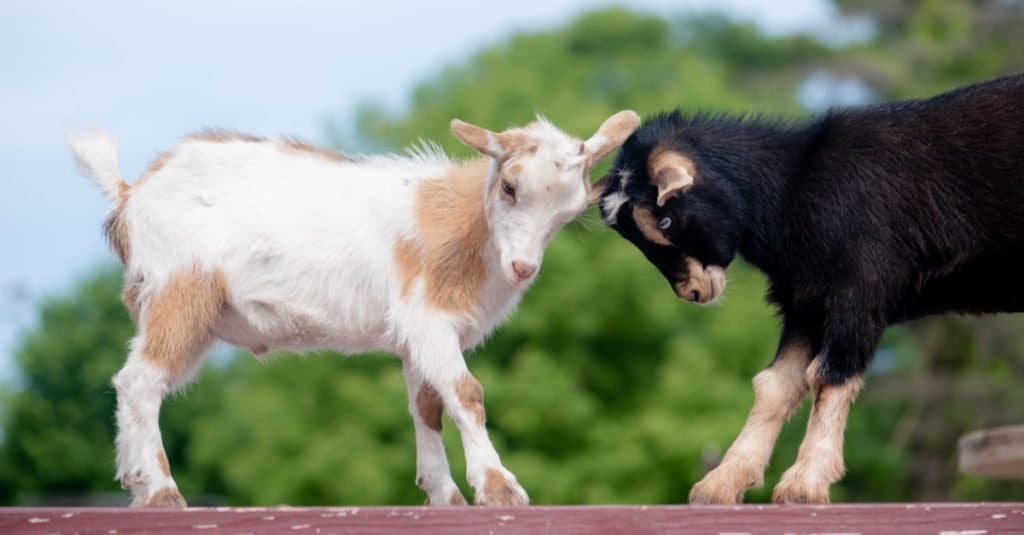
©Debra Anderson/Shutterstock.com
Behavior
The description of Nigerian Dwarf goats includes characteristics of precocity, intelligence, playfulness, curiosity, gentleness, friendliness, and low maintenance. They make excellent pets for anyone who wants an unconventional companion, children, the elderly, and the disabled. Hornless or polled goats are worth more but are a good option to avoid getting hurt from their headbutting. Nigerian Dwarf goats are calm but hardy and can adapt well to a variety of environments. A group of goats is called a tribe or trip.
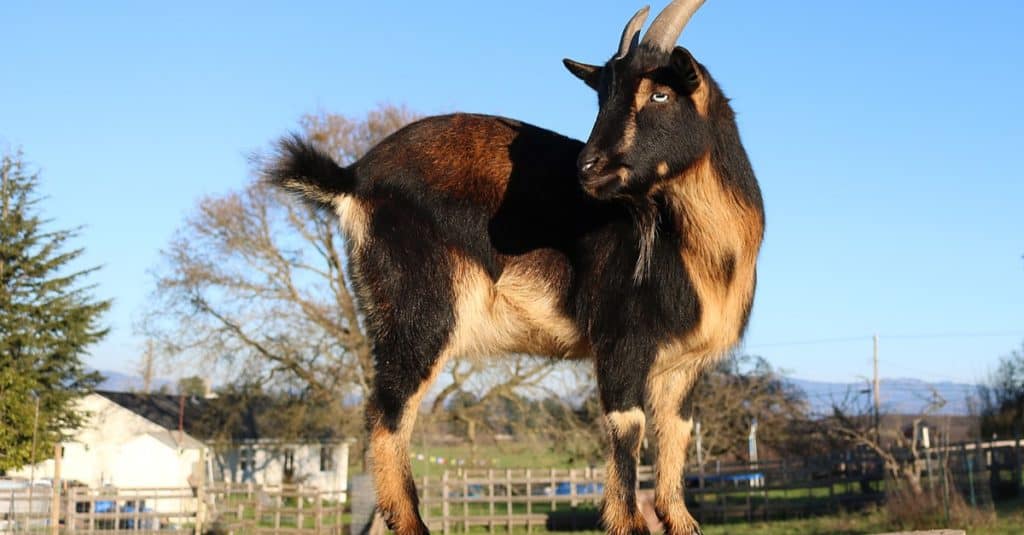
Nigerian goats make excellent pets due to their intelligent and mild personalities.
©Hollysdogs/Shutterstock.com
Habitat
Nigerian dwarf goats were initially exhibited in zoos, but they do well in both and small homesteads and farms. They are a good choice for suburban homesteaders who don’t have a lot of space and can provide a dog box shelter and a fenced-in backyard for their homes.
The ancestors of Nigerian dwarf goats originated in the harsh conditions of Central and West Africa where there are hot, humid plains, valleys, and other environments. They are valued for needing less feed and producing more milk than other, larger breeds, and are useful for meat, milk, wool, and leather. Although wild goats come from Asia and Europe, they were separately domesticated and developed in different countries.
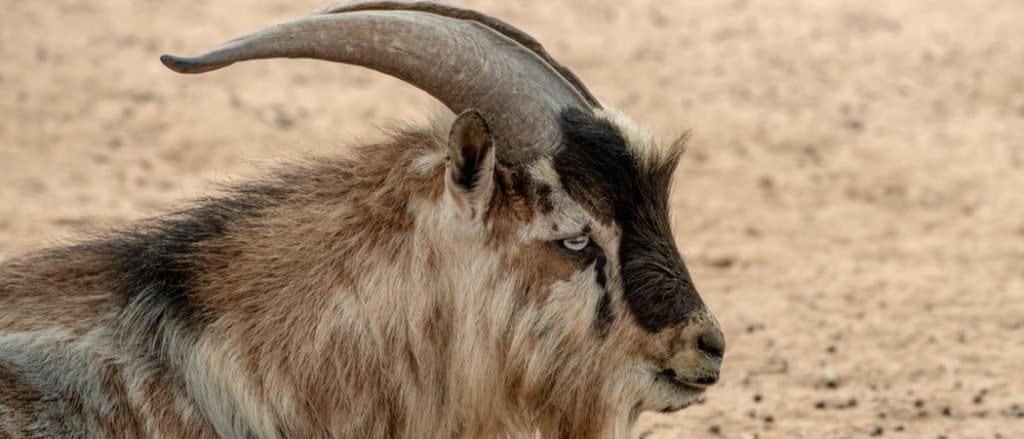
Nigerian dwarf goats can be found in zoos, farms, and backyards.
©Steven Salgado/Shutterstock.com
Diet
The description of the Nigerian dwarf goat is an ungulate, or a hoofed animal, and a ruminant, or an animal that chews cud. For the care of lactating does or baby goats, or kids, they do well with a diet of alfalfa hay with proper protein, while the diet for adults is 90% of a legume/grass hay mixture plus grains, seeds, herbs, minerals, and supplements. Goats are useful for clearing brush and will graze to supplement their primary food source.
However, there are poisonous plants to take care to watch out for. Snakeweeds and ponderosa pine needles induce abortions, while lupine, nicotiana glauca, and poison hemlock cause birth defects. There are plants with other possible negative effects, including common herbs and grasses:
- Bracken fern causes aplastic anemia.
- Bermudagrass, Johnsongrass, Sorghum Forage, Laurel Cherry, Choke Cherry and Black Cherry cause cyanide poisoning.
- Oleander, Gossypol, Mountain Laurel, Azaleas, Rhododendrons, Leucothea, Lyonia, Japanese Yew, Ergot, and certain Fescues cause heart dysfunction.
- Tung Oil Tree, Buttercup, Privet, Bladderpod, Rattlebox, Tallow Tree, Nightshades, Death Camas, and Pokeweed cause digestive issues.
- Aflatoxins, Cocklebur, Crotalaria, Lantana, Moldy Forage, and Bluegreen Algae cause liver failure.
- Coffee Senna and Sicklepod cause muscle dysfunction.
- Dallisgrass, Bermudagrass, Carolina Jessamine, Phalaris, Buckeye, Water Hemlock, Poison Hemlock,
Zigadenus spp and White Snakeroot cause nervous system issues. - Corn Stalks, Sorghum, Millet, Ryegrass, Bermudagrass, Wheat, Amaranthus cause nitrite or nitrate poisoning.
- Perilla Mint, Sweet Potato, Pasture Forages, and Peanut Hay cause lung dysfunction.
- Oak, Amaranthus, and Dock cause kidney failure.
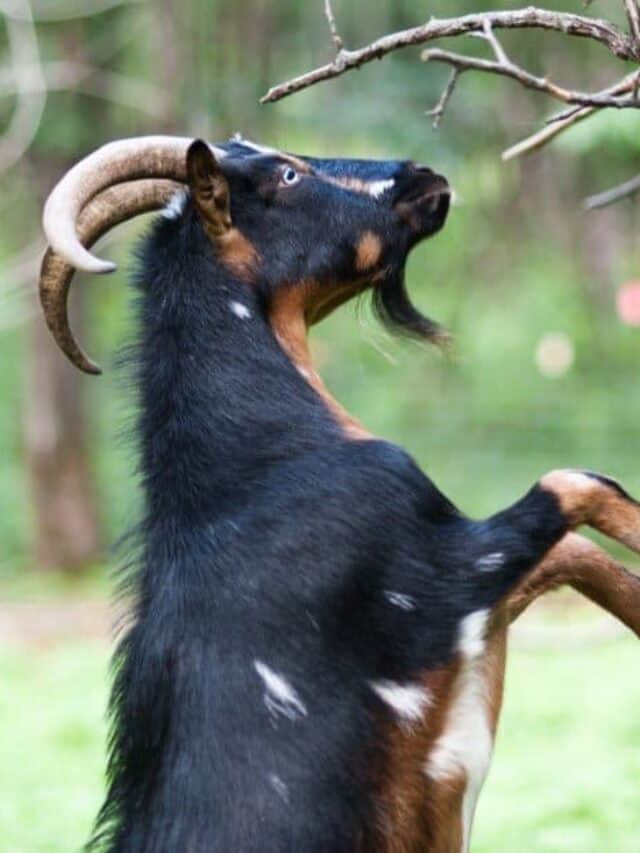
Nigerian goats eat bark from trees. They also graze to supplement their meals.
©BillyWallsPhoto/Shutterstock.com
Predators and Threats
Goats have large predator mammals that attack them, including eagles, dogs, coyotes, foxes, and wolves. Eagles can snatch and carry away kids and even adult Nigerian goats. Bobcats, mountain lions, and bears are also possible threats although they tend to prefer larger prey, so owners must take care to supervise the goats, especially vulnerable pregnant does, mothers, and kids. If owners have a farm or homestead that is larger and in rural areas, a herding dog can act to help watch and protect the livestock.

Eagles prey upon young and even adult Nigerian dwarf goats. They can grab them with their talons.
©iStock.com/Genfirstlight
Reproduction and Life Cycle
Nigerian dwarf goats can breed year-round. Some owners prefer limiting breeding their does to three times in two years, giving a minimum break of 6 months. Gestation is 145-154 days while giving birth to 2-4 babies at a time, and the does often do not need help during the process. Lactating goats can produce 1 to 8 pounds of milk a day but on average 3 to 4 pounds of milk with 6 to 10 percent butterfat, and for up to 10 months out of the year.
A baby goat is called a kid, and kids can be weaned as early as 30 days but ideally 6 to 8 weeks. The goats are sexually mature at three to four months for males and seven to eight months for females, while they both reach full adult maturity at 24 months. A herd of goats is called a tribe or trip. Their lifespan is about 15 years.
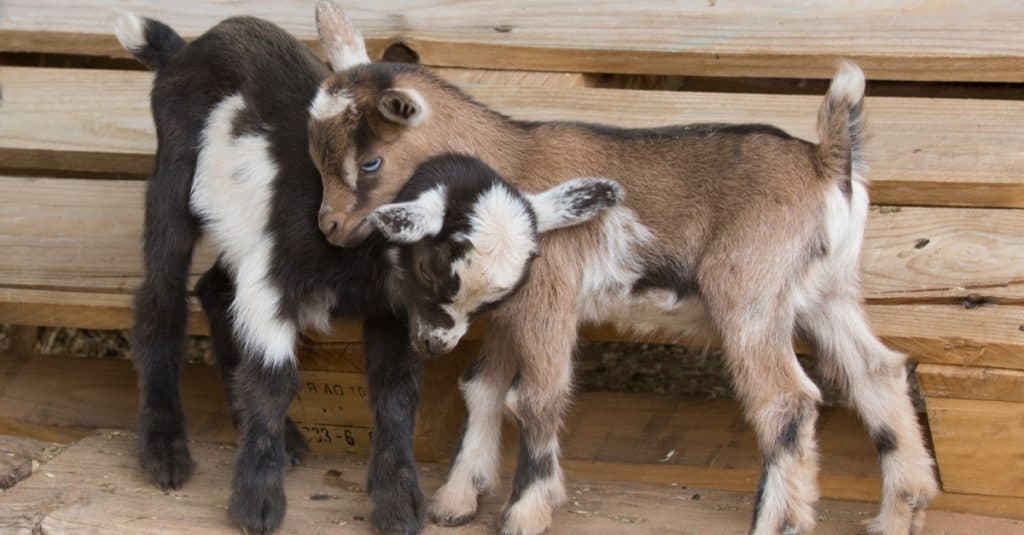
Mother Nigerian goats give birth to 2-4 kids at a time.
©MelaniWright/Shutterstock.com
Population
The ancestors of Nigerian dwarf goats, West African dwarf goats are major livestock in 15 countries across West and Central Africa. They serve as a livestock source for meat, milk, wool, and leather.
View all 65 animals that start with NNigerian Goat FAQs (Frequently Asked Questions)
What are Nigerian goats good for?
Being a livestock source for meat and milk, a show animal, and a companion animal.
How big do Nigerian goats get?
Males are 16-24inches in height and 50-70lbs, while females are 16-22inches in height and 40-70lbs. They reach full maturity at 24 months of age.
How long do Nigerian goats live?
The lifespan of Nigerian goats is about 15 years. Compared to other pets, this lifespan is considered a long time.
How much is a Nigerian dwarf goat?
As much as a full-sized dairy goat, up to $500.
How many Nigerian goats are left?
As a major source of income and livelihood in Africa and the United States, populations of Nigerian dwarf goats are not under threat.
Are Nigerian goats carnivores, herbivores, or omnivores?
Like other goats, they are herbivores.
Thank you for reading! Have some feedback for us? Contact the AZ Animals editorial team.
Sources
- Wikipedia / Accessed June 21, 2021
- Hot Vibes Media / Accessed June 21, 2021
- Predator Guard / Accessed June 21, 2021
- Rosevine Cottage Girls / Accessed June 21, 2021
- Backyard Goats / Accessed June 21, 2021
- Farm Desire / Accessed June 21, 2021
- Roy's Farm / Accessed June 21, 2021
- Better Hens & Gardens / Accessed June 21, 2021
- Barn Coop / Accessed June 21, 2021
- New Life on a Homestead / Accessed June 21, 2021
- Reference / Accessed June 21, 2021
- Nigerian Dwarf Goat: Colors and Patterns / Accessed June 21, 2021
- Petkeen / Accessed June 21, 2021
- Knowledge Base / Accessed June 21, 2021
- Nigerian Pygmy Goats / Accessed June 21, 2021
- Weed 'em & Reap / Accessed June 21, 2021
- The Livestock Conservancy / Accessed June 21, 2021


















